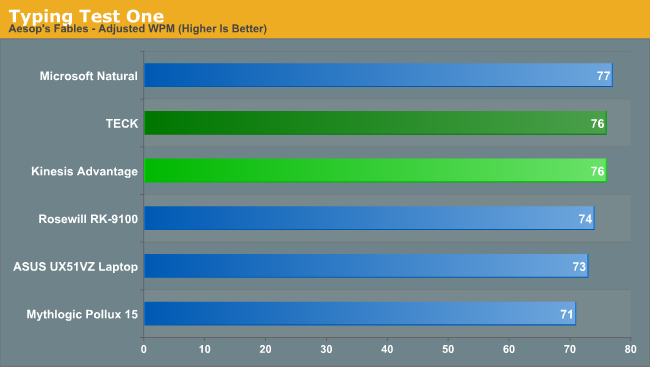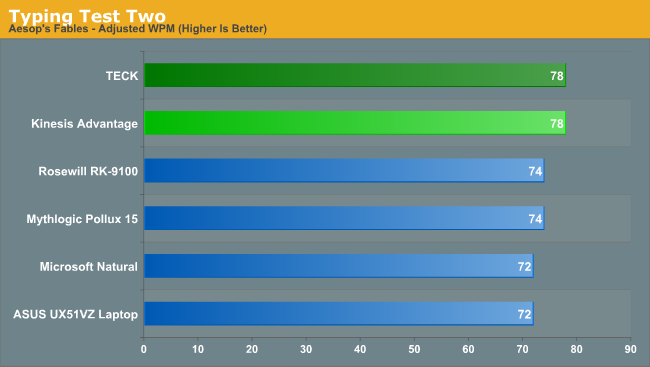Kinesis Advantage Review: Long-Term Evaluation
by Jarred Walton on July 2, 2013 10:15 PM ESTMore Subjective Thoughts and Typing Speed Results
So far I’ve covered a ton of items that may or may not affect individual users, but the real questions are almost certainly not yet covered. Is the Kinesis more comfortable for typing than typical keyboards, is it better than the TECK, and what about typing speed—did it make me a faster typist? I’ll tackle the last item in that list first, as it’s probably the easiest one to answer.
As far as the regular typing tests that I’ve tried on other keyboards, let me first start by saying that I feel like I’m mostly “tapped out” on speed, regardless of what keyboard I happen to be using. I can’t say whether or not Dvorak or some other layout could further improve my speed, but most things I’ve read suggest at best a 5-10% performance in typing speed, and that’s after potential a month or more of training and acclimation to get used to the alternate layout (and some difficulties every time you switch to a system that doesn’t use a Dvorak layout).
What that means for me in particular is that I generally won’t break 80WPM—I just don’t have it in me. I have a sister-in-law who is an accomplished pianist, and she can hit 100+ WPM on a regular keyboard, and I know others that can pull off that feat as well. Personally, 60-70 WPM is plenty fast for what I do, as most of the time I’m sitting at the computer I need to think of what to write more than I wait for my fingers to put thoughts to text.
Since I’ve now tested two ergonomic keyboards along with using regular keyboards and laptops, I can at least make some graphs—hey, it’s AnandTech and I know you all want graphs, right? The margin of error for these sorts of tests is much greater I think, so consider anything within 3 WPM to be essentially a tie. For this roundup, I’ve got my results from the TECK, the Kinesis Advantage, the Rosewill RK-9100, an MS Natural (old model PS/2 connector from about ten years ago), and just for good measure I threw in results using ASUS UX51VZ and Mythlogic Pollux 15 laptops (the latter uses a keyboard similar to the MSI SteelSeries, only on a Clevo chassis).
Given the amount of time I’ve now spent taking the various typing tests, I felt it would be best for me to go back and retake tests on some of the other keyboards, so scores are changed from my previous typing speed articles. I repeated each test multiple times on a keyboard until I felt I had a run that was representative of the best I could reasonably manage—where I’d expect to end up if I used the keyboard as my sole option for a while. I also tried taking the test again on the TECK, and unfortunately even after 20 tries I just wasn’t getting very good results; it seems that a couple months without every day use of the TECK was enough for me to start losing muscle memory of where the keys are located. For the TECK, I used the best results that I obtained when I was at my peak, at the time I finished the TECK review.




At the very least, in what is a less deterministic metric, I seem to consistently top out at around the same point on the various keyboards. In some cases I’m slightly faster on the two mechanical ergonomic keyboards, but overall most of the results are close enough to be considered a tie.
Where I’m absolutely not doing that well on the TECK and Advantage is in 10-key speed, and the laptops with their slightly smaller [0] keys are also suffering. Interestingly, I did best on the 10-key with the old MS Natural—and I confirmed that 10K+ result several times. The Rosewill should be similar, but I consistently scored in the 9000-9500 range (sometimes even dropping into the 8500-9000 range). The absolute best results I got on both the TECK and Kinesis are listed in the charts, and while practice might help me improve I have to be honest: their 10-key implementations leave a lot to be desired. The TECK in particular has the various keys all over the place, while the Kinesis is mostly just a case of being a little different than a typical 10-key.
One nice aspect of the Kinesis 10-key is that the “Keypad” button actually affects more than just the numeric keypad, which can be somewhat useful at times, but more importantly if you plug into a system that has NumLock active you won’t immediately get numbers—the NumLock function of the Kinesis exists separately from the 10-key. So if you want the cursor keys and document navigation keys on the right hand, you can get that functionality.
In terms of speed, then, these high-end ergonomic keyboards don’t appear to add much to my typing speed, but at least after training I’m not any slower. Others are likely to have better/worse results—some will see more, and undoubtedly some will see lower speeds (particularly early on in the use of a new keyboard)—but for the most part typing speed doesn’t seem to change much with keyboard. For speed purposes then, I wouldn’t recommend people go and shell out $200-$300 (or more) on a mechanical ergonomic keyboard, but what about for other benefits?
I feel when using both the TECK and Kinesis that I have to reach and move my hands and fingers around less. Some might say that’s a bad thing (i.e. it might make you more stiff and cause you to tighten up muscles in the hands and fingers), but at least in terms of how it feels I have to say that less stretching to reach keys is more comfortable for me. More comfortable however doesn’t mean that the use of such keyboards is a way to “cure/fix” CTS/RSI/tendonitis issues caused by frequent use of a computer keyboard. Every keyboard I’ve seen carries some form of warning about the risks of extensive typing, with recommendations to take breaks, stretch, etc. The Kinesis and TECK are no different, and if you need to really see about addressing health related concerns brought on by excessive typing, you’ll probably want to look at something that doesn’t require use of a keyboard at all (e.g. Dragon Naturally Speaking).
As for what this means to me personally, I cannot say that my hands and wrists feel substantially better after using either keyboard, but at the same time I would say they’re definitely no worse. Perhaps an MRI or some other diagnosis would be able to shed more light on the subject, but for now I’m willing to leave it be. I enjoyed using both keyboard for various reasons, and I have my gripes about each design as well. Which is better is a matter of preference, but since this is my own review/opinion piece let’s get to the conclusion.










67 Comments
View All Comments
JarredWalton - Wednesday, July 3, 2013 - link
This is mostly what I was trying to get at with the gaming discussion in the article, but I suppose I stopped before fully completing the circle. Basically, yes it can be used for games, but it will in practice requires you to remap the default keys in virtually every game, as well as potentially needing to use the Kinesis remapping feature to also switch out the Backspace and Delete keys. It goes back the the whole "standard keyboard" phrase again: the Advantage isn't a standard layout and thus you have to resort to custom mappings. But the key action, number of keys you can use at once, etc. should be a problem.Now I'm going to go add the above to the article....
JarredWalton - Wednesday, July 3, 2013 - link
Edit: that second to last sentence should say "should *not* be a problem".Azethoth - Saturday, July 6, 2013 - link
That is why you get a Cyborg RAT MMO7 for your mouse. It has a good set of extra buttons you can pick from to supplement your ESDF keyboard setup (making sure your mousepad is red so it helps and not hinders the laser).branney - Saturday, July 6, 2013 - link
the advantage of USB keyboards is that you can have more than one plugged in at once, which only leaves physically swapping the keyboards, but at least you don't have to fiddle with wires. any avid PC gamer worth their salt would probably not mind making space for an extra keyboard? i have made do with a gaming steering wheel permanently fixed on my desk above the keyboard tray for almost a decade and a half!glockjs - Tuesday, July 2, 2013 - link
I need a TL;DR in effect to: Do you think the price tag is justifiable enough to save my hands over the long run? Is it that much more natural/comfortable vs a normal keyboard? etc etc...f54 - Wednesday, July 3, 2013 - link
To me, the TL;DR is "Yes, it's worth it because prevention is better than the cure." I've had the Advantage since 2008 when I started to develop pain in my shoulders, arms, and hands. I debated a lot about the cost, then was reminded a friend who went through surgery and therapy. The pain of spending ~$300 is much less than that.That being said, I was using a Microsoft Ergonomic 4000 (which I now realize is a bad design) before that and had really bad shoulder pain. Simply moving the mouse to my left hand helped a lot since I didn't have to stretch my hand so much. That's a free ergonomic upgrade. Moving the mouse probably did more for me than buying the Advantage, but I still think the Kinesis is worth it because it did help a lot.
f54 - Wednesday, July 3, 2013 - link
Somebody else posted this, but another option is the Kinesis Freestyle. For 1/3 the price you get an adjustable split keyboard and no numpad, which (IMO), are the two biggest plus points of the Advantage.everythingis1 - Wednesday, July 3, 2013 - link
As a Kinesis Freestyle owner, I can say that it is a the most ergonomic keyboard for the money, but it is pretty terrible to type on and is of poor overall quality.shinjin - Saturday, July 6, 2013 - link
Let me put it this way. I've been using a Kinesis at home and work (software development) for ~17 years or so. Relatively recently I switched to a 'regular' wireless Logitech keyboard that is roughly the size of a laptop keyboard, when you ignore the 10-key keypad. After 6 months of this torture I switched back to the Kinesis. This laptop-sized keyboard had my wrists packed so closely together and contorted so badly that my wrists and forearms were just screaming.hrbngr2 - Tuesday, July 2, 2013 - link
Jarred,I made a similar comment in your initial review of the Kinesis keyboard, but I wanted to reiterate how much using the footswitch along the the "Advantage" model helped with my RSI issues. I used the single button footswitch and then set it to emulate the "shift" key. Once that was configured, I was able to type Capital letters without having to use my pinkie fingers to hold down the regular shift key. It really reduced the fatigue in my weak pinkie finger and made a real difference in my pain levels. I really recommend you giving it a try.